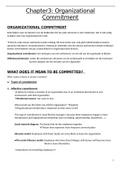Chapter3: Organizational
Commitment
ORGANIZATIONAL COMMITMENT
Enkel kijken naar de talenten van de bedienden die hun jobs uitvoeren is niet voldoende. Het is ook nodig
te kijken naar hun organisatorische inzet.
Veel te vaak nemen werknemers plots ontslag. Dit kost echter zeer veel geld (administratieve kosten,
opnieuw rekruteren, screening kosten, training en oriëntatie voor de nieuwe werknemer) alsook verborgen
kosten (verminderde moraal, productiviteit en organisatorische kennis).
Organizational commitment: Het verlangen van een werknemer om een lid van de organisatie te blijven.
Withdrawal behavior: Acties die werknemers uitvoeren om de werksituatie te vermijden en die eventueel
kunnen oplopen tot het verlaten van de organisatie.
WHAT DOES IT MEAN TO BE COMMITTED?
What creates a desire to remain a member?
A. Types of commitment
1. Affective commitment
=A desire to remain a member of an organization due to an emotional attachment to and
involvement with that organization.
Emotional reasons: You want to stay
What would you feel when you left the organization? Sadness
Organizational membership is important to their sense of self
This type of commitment is most liked by managers, because these employers engage in more
interpersonal and organizational citizenship (such as helping, sportsmanship, boosterism, …)
Social network diagram: The bonds that tie the employees together
Thicker lines represent more frequent communication
Erosion model: Employees with fewer bonds are more likely to leave the organization
The social influence model: Employees who have direct linkages with leavers will become more
likely to leave themselves
Importance of connecting employees!!!
1
, 2. Continuance commitment
=A desire to remain a member of an organization because of an awareness of the costs associated with
leaving it.
Cost-based reasons: You need to stay
What would you feel when you left the organization? Anxiety
employees associate a profit with staying and a cost with leaving
Continuance com. gets increased by the total amount of investment (time, energy, …)
Effort may be wasted when changing of employement
Alternatives depend on several factors such as economic conditions, marketability of a person’s skills, ..
This creates a passive loyality
Embeddednes: Summarizes employees links to their organization and community.
-Links (Worked for a long time, many friends, …)
-Fit (The job utilizes my skills and talents well, the weather where I live is suitable, …)
-Sacrifice (I would sacrifice a lot if I let this job, people respect me in this community, …)
3. Normative commitment
=A desire to remain a member of an organization due to a feeling of obligation.
Obligation-based reasons: You ought to stay
What would you feel when you left the organization? A sense of guilt
You ‘should’ stay derived from work philosophies or more general codes of right and wrong
Sense of obligation-based commitment van be build in two ways:
-A feeling that employees are in the organizations debt (They have gotten education, …)
-By becoming a particularly charitable organization
Corporate volunteering gives credit to the employees (younger ones are more charitable)
Focus of commitment: Not only commitment does not only depends on just the organization, it also
depends on the top management, their department, the manager, coworkers, …
Commitment types may vary over the course of a career
B. Withdrawal behavior
A study suggested that 60 percent of employees plan to look for another job once economy improves.
Organizational commitment is a vital concern Though times put employee’s loyalty and allegiance to the
test
2





